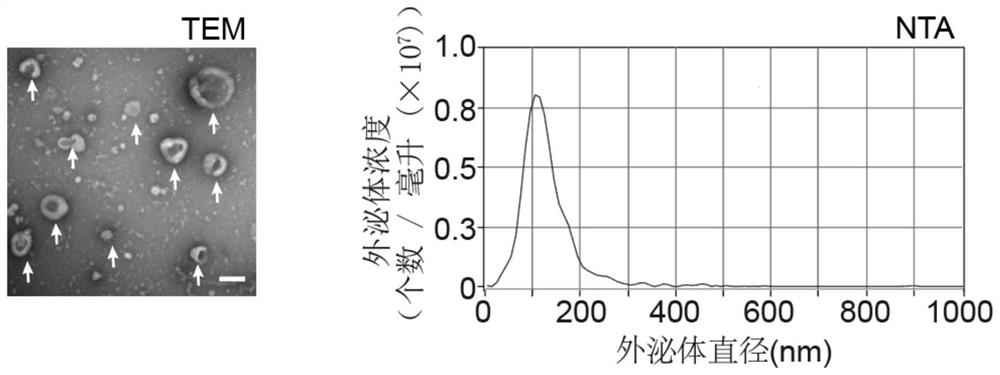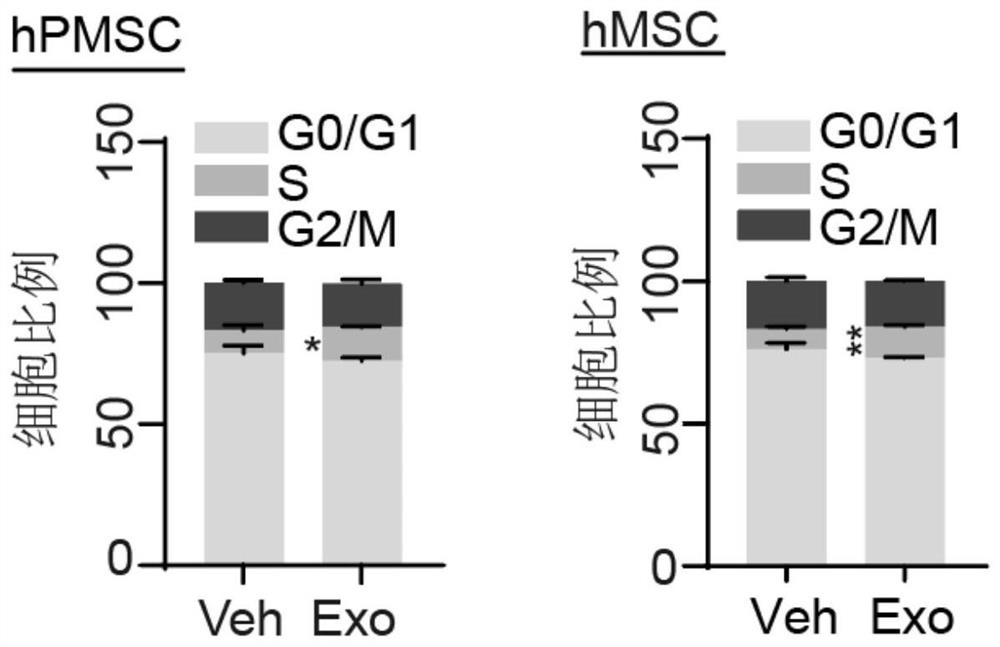Application of atler stem cell exosome in preparation of products for improving or treating osteoarthritis and delaying cell senescence
An osteoarthritis and exosome technology, applied in the field of biomedicine, can solve the problems of limiting the application of cell transplantation, low survival rate and survival time, etc., and achieve the effect of wide application prospect, reducing cartilage damage and stable treatment effect.
- Summary
- Abstract
- Description
- Claims
- Application Information
AI Technical Summary
Problems solved by technology
Method used
Image
Examples
Embodiment 1
[0066] Example 1 Extraction and identification of velvet antler stem cell exosomes
[0067] 1. Antler stem cell culture
[0068] Antler stem cells isolated from sika deer antler were placed in a petri dish at 37°C, 5% CO 2 The culture medium was incubated in an incubator, and the medium used was MSC medium, and the components included MEMα basal medium (Thermo Fisher Scientific), 10% fetal bovine serum (Thermo Fisher Scientific), 1% penicillin / streptomycin (Thermo Fisher Scientific), 0.1 mM NEAAs (MSC Thermo Fisher Scientific), 1ng / mL FGF2 (JointProtein Central. Fetal bovine serum needs to be centrifuged at 100,000×g for 16 hours at 4°C to remove exosomes before preparing the medium, and the supernatant is taken for later use.
[0069] 2. Extraction of exosomes from velvet antler stem cells
[0070] When the antler stem cells grew to 80% confluence, the fresh medium was replaced, and the conditioned medium was collected for exosome purification after continuing to culture fo...
Embodiment 2
[0073] Example 2 Antler stem cell exosomes delay the process of replicative aging of human mesenchymal stem cells
[0074] 1. Detection of monoclonal formation ability
[0075] The late-generation (P12) human-derived mesenchymal stem cells hMSC (derived from embryonic stem cells) and the late-generation (P12) human-derived mesenchymal stem cells hPMSC (derived from tissue) were selected for the detection experiment of monoclonal formation ability. hMSCs and hPMSCs were seeded in collagen-precoated 12-well culture plates at a density of 3000 per well, respectively. A phosphate buffer treatment group and an exosome treatment group were set up to treat the cells, with 3 wells in each group, and the medium was changed and treated every other day. Phosphate buffered saline treatment group (Veh): Cells were incubated at 37° C. in 5% CO in MEMα+PBS (liquid medium obtained by adding 10 microliters of phosphate buffered saline to 1 ml of MEMα basal medium in Example 1) 2 Cultured und...
Embodiment 3
[0098] Example 3 Therapeutic Effect of Antler Stem Cell Exosomes on Osteoarthritis
[0099] The mouse osteoarthritis model was established with C57BL / 6J mice according to the literature method. Build method: "XiaoqingRen, Boqiang Hu, Moshi Song, Zhichao Ding, Yujiao Dang, Zunpeng Liu, Weiqi Zhang, Qianzhao Ji, Ruotong Ren, Jianjian Ding, Piu Chan, Changtao Jiang, Keqiong Ye, JingQu, Fuchou Tang, Guang-Hui Liu.Maintenance of Nuclear Homeostasis by CBX4Alleviates Senescence and Osteoarthritis.Cell Rep.2019;26(13):3643-3656.”
[0100] Osteoarthritis model mice weighing 20-25 g and 8 weeks old were randomly divided into three groups, Sham group, OA+Veh group and OA+Exo group, with 15 mice in each group. Sham group was the sham operation control group.
[0101] One week after operation, the OA+Veh group and OA+Exo group began to inject phosphate buffer saline or exosomes into the joint cavity for intervention, and the intervention interval was once a week for 8 weeks. After 8 we...
PUM
 Login to View More
Login to View More Abstract
Description
Claims
Application Information
 Login to View More
Login to View More - R&D
- Intellectual Property
- Life Sciences
- Materials
- Tech Scout
- Unparalleled Data Quality
- Higher Quality Content
- 60% Fewer Hallucinations
Browse by: Latest US Patents, China's latest patents, Technical Efficacy Thesaurus, Application Domain, Technology Topic, Popular Technical Reports.
© 2025 PatSnap. All rights reserved.Legal|Privacy policy|Modern Slavery Act Transparency Statement|Sitemap|About US| Contact US: help@patsnap.com



